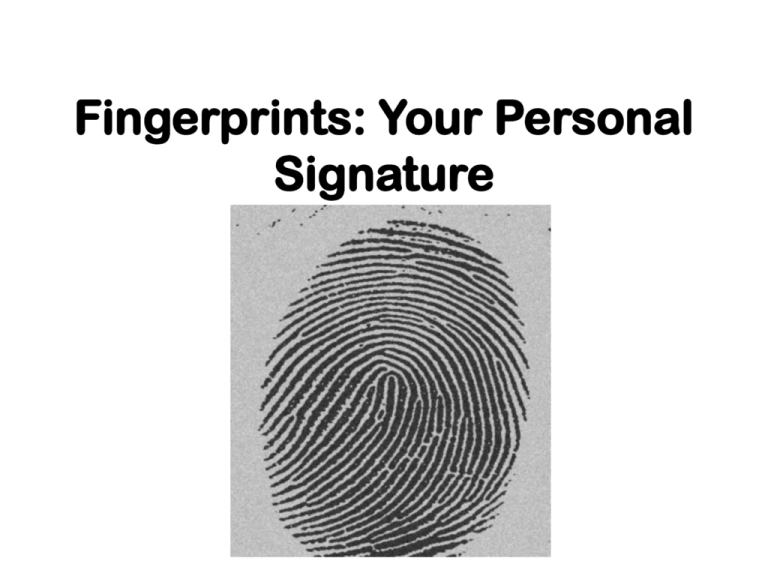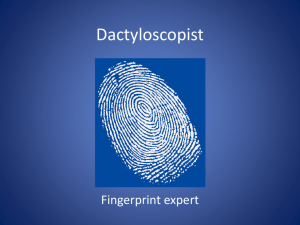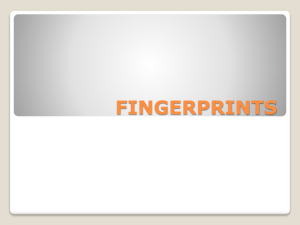Fingerprints: Your Personal Signature
advertisement

Fingerprints: Your Personal Signature Fingerprint History • Pre-History-Early potters identify their works with an impressed fingerprint • 1000BC-Chinese sign legal documents using fingerprints • 1685-Marcello Malpighi first recognizes and describes fingerprint patterns. • 1823-JohannesPurkinjie establishes 9 basic fingerprint patterns and rules for classifying them. • 1858-Sir William Herschel first notes the individuality of handprints, and finds they remain unchanged after 50 years. Fingerprint History Cont • 1892-Sir Francis Galton publishes the textbook Finger Prints in which he offers convincing evidence that no two prints identical. • 1899-Sir Edward Henry devises a classification system based on five types of prints. This system is the basis for ones used in the US and Britain today. • 1910-Thomas Jennings becomes the first person convicted in the US on fingerprint evidence. Anthropometry: A Precursor to Fingerprinting • Anthropometry is the science of measuring humans. • First developed by Alphonse Bertillon, and became known as Bertillonage in the late 19th century. • System collected numerous body measurements and categorized various facial features of a person – According to Bertillionage measurements the odds of two people being the same where 286 million to one. Difficulties with Bertillionage Measurements • A Bertillionage catalogue included: – Photographs of each person – A set of complex anthropometric measurements and feature classifications were collected on a card. • The complexity of the system made it difficult and it gave way to a new identification method—fingerprinting—in early 20th century Anatomy of a Fingerprint • Finger pads-Fleshy service of the finger used for touching and gripping. • Grooves, and friction ridges arranged in patterns. Ridgeology • Ridgeology: The study of the uniqueness of friction ridge structures and their use for personal identification. • The uniqueness of a fingerprint can be determined by the pattern of ridges and valleys as well as the location, shape, and position of minutiae points. – Minutiae are points where ridge structure changes Basic and composite ridge characteristics (minutiae) Example Minutiae Short Ridge Bifurcation Bridge Dot Double Bifurcation Enclosure (Lake) Example Minutiae Trifurcation Hook Opposed Bifurcation Opposed Bifurcation/ Ridge Ending Ridge Crossing Ridge Ending Classifying Prints • Patterns: – Arches • Ridgelines that rise in the center to create a wavelike pattern. Subgrouped into plain or tented. Only 5% of all pattern types are arches. Plain Tented Classifying Prints Cont – Loops-comprised of one or more ridges that double back on themselves. About 60% of patterns in human fingerprints are loops. • Radial loops flow downward toward the radius (thumb side) Classifying Prints Cont • Ulnar loops flow downward toward the ulna (little finger) side. Classifying Prints Cont – Whorls-Look like little whirlpools of ridgelines. They are characterized by 2 or more deltas. Whorls make up 35% of patterns in human fingerprints. • Plain Whorls-are either concentric circles or spiral Delta Delta Classifying Prints Cont • Central pocket loop whorls-resemble a loop with a whorl at its end. Classifying Prints Cont • Double loop whorls-Include two loops that collide to produce an S-shaped pattern Classifying Prints Cont • Accidental loop whorls-Slightly different from other whorls and are irregular. Quick Tips • If a fingerprint has no deltas, it is an arch. • If a fingerprint has one delta, it is a loop. • If a fingerprint has two or more deltas, it is a whorl. The Henry Classification System • Developed by Sir Edward Henry in the late 1800s for criminal investigations in British India. • Was the basis of modern day AFIS classification methods up until the1990s. • Using the Henry system, individual prints are assigned scores based on where a whorl shows up within a 10 finger set of prints. The Henry Classification System Cont. L L Ring L Pinky Middle L Index L R R Thumb Thumb Index R Middle R Ring R Pinky Finger # 10 9 8 7 6 1 2 3 4 5 Value (if Whorl is present) 1 1 2 2 4 16 16 8 8 4 The Henry Classification System Cont. • The fingerprint record’s primary grouping is determined by calculating the ratio of one plus the sum of the values of the whorl-patterned, even-numbered fingers; divided by one plus the sum of the values of the whorl-patterned, odd-numbered fingers • 1+((Sum whorled, Even finger value) (Sum whorled, Odd finger value)) =Primary Grouping Ratio The Henry Classification System Problems • This system separates fingerprint files into 1,024 groups. • Investigators then had to analyze the minutiae by hand in order to match the prints. • Analyzing and matching a set of prints could take months • Criminals did not always leave behind a full set of 10 prints. AFIS technology (Automated Fingerprint Identification System) • Collaboration between the FBI and the National Institute of Standards and Technology(NIST) in the 1960’s • The Henry Classification System has been a highly influential force in the formation of current AFIS technology. • Primarily envisioned used as a tool to expedite the manual searching of fingerprint records, eventually reducing matching time requirements from months to hours. AFIS Technology Cont. • Up until the mid 1990s, it was not unusual for a state or city to continue to maintain its physical file of Henry-sorted fingerprint cards just in case a disaster occurred in the AFIS. • AFIS began to classify fingerprints according to the distance between the core and delta, minutiae locations, and pattern type. Interesting Facts • Did you know? – Police investigators are experts in collecting “dactylograms”, otherwise known as fingerprints. – The koala is one of the few mammals (other than primates) that has fingerprints. In fact, koala fingerprints are remarkably similar to human fingerprints; even with an electron microscope, it can be quite difficult to distinguish between the two.






